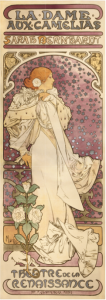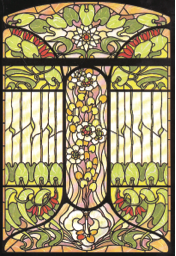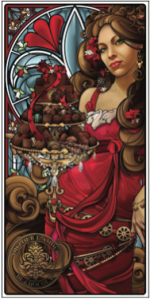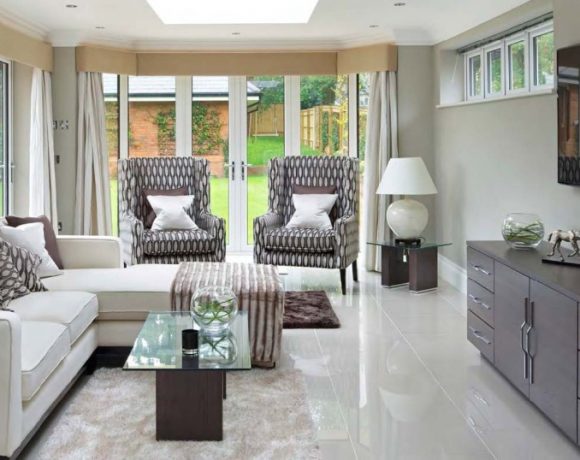By Michael Pacitti
Inspired by the unruly aspects of the natural world, the Art Nouveau style affected art, illustration, design and architecture from 1890 to 1910. Despite its relatively short span as a popular trend, Art Nouveau made many appearances throughout the decades, including a secondary highlight during the 1970s psychedelic movement. Remember the Grateful Dead’s album covers? Pure Art Nouveau! Even today, the Art Nouveau style still permeates the framing industry.
The phrase “Art Nouveau” translates to “new art” or “modern art.” Originating in France and Germany, the style was characterized by sinuous, undulating lines that sensualized the design world. It featured flowing organic motifs and ornaments with graceful, flowing edges, like a curling whiplash. Artists and artisans often based the asymmetrical patterns on plant shapes such as flowers, vines, leaves and seaweed. Small insects and birds were also key motifs in the Art Nouveau movement.
Art Nouveau contrasted with the later style of Art Deco, which emerged in the early 1920s soon after the popularity of Art Nouveau waned. While Art Deco is still, rigid, defined and motionless, Art Nouveau portrays life, motion and continuity.
Art Nouveau revolutionized the way people looked at the objects that made up their world. As a period in design, Art Nouveau could be considered more of a movement rather than a style, transforming the Victorian era with new, modern imagery. The movement coincided with the Industrial Revolution and brought new approaches to interior design, architecture, furniture, fabrics, glass, tableware, jewelry, frames, posters, wallpaper, textiles and lighting. The style embraced new materials including molded bubble glass, animal horns, ivory tusks and semiprecious stones. It was also very prominent in the styling and production of stained glass that originated in England and incorporated many Art Nouveau styles, shapes and patterns.
Art Nouveau affected the design of the most everyday objects including utensils, hardware and furniture. The movement resisted classical restrictions. Rather than limit art to a canvas or traditional sculpture, Art Nouveau expanded the artistic premise by turning everyday objects into art. The artists incorporated the distinctive Art Nouveau curves and flowing lines to a painting; added a dimensional dragonfly to door decor; or graced doorway moulding with flowers, vines and leaves.
As with any new style introduction, critics and exhibit attendees either loved the style or loathed it. But boosted by its appearance at the 1900 World’s Fair in Paris, the movement flourished across the globe. In the United States, Art Nouveau emerged naturally from the craft tradition and trades of the early 19th century. Soon, North American designers contributed their own ideas to the Art Nouveau style, particularly in ceramics, glassware, architecture and frames. In the United States, a new style of glass art surfaced as Louis Comfort Tiffany took interest in Art Nouveau. Tiffany’s lamp designs are still renowned today.
Furniture designers also embraced the forward-thinking Art Nouveau movement, using the new organic, flowing motifs in defined furniture rather than regimented architectural patterns. Like fine artists, Art Nouveau furniture designers drew inspiration from the natural world and shared the same belief in quality goods and fine craftsmanship. They embraced mass production and combined the ornate Rococo style with botanical influences. Charles Macintosh of Scotland had a particularly profound impact on furniture design and style, and is considered one of the fathers of Art Nouveau furniture.
In the print world, Art Nouveau became one of the first major artistic movements. The concept of mass-produced images and graphics played a significant role in the industry, incorporating color-printing techniques that were relatively new at the time. Art Nouveau designers painted, drew and printed work for popular forms such as advertisements, posters, labels and magazines. The poster craze of the 1890s spread throughout Europe and America.
In early 1895, Paris artist Alphonse Mucha debuted his work with a lithographed poster for the play Gismonda featuring Sarah Bernhardt. The look and design of this poster not only popularized the Nouveau style, but identified and spread the concept of the design throughout Paris. Although originally called Mucha Style, it soon became a major part of Art Nouveau. Mucha went on to produce thousands of advertisements, illustrations, paintings and designs.
Many other artists of the time interpreted Art Nouveau as part of their own styles, including painter Gustav Klimt, glass designer René Lalique and architect Antoni Gaudí.
Today, contemporary illustrator Echo Chernik captures the essence of Art Nouveau in her modern work. Her concept of “total art” can be found framed in many styles of Art Nouveau period frames and on display throughout the Bellagio Resort in Las Vegas. Her paintings illustrate the sensuous lines and subtle light of Art Nouveau and feature feminine figures with long, flowing hair. Chernik’s success shows that Art Nouveau’s symbolism and motifs are still appreciated by the art world today.
Michael Pacitti is publisher of DECOR magazine and Show Director for DECOR Expo Showcase. He has worked in the interior design, art, photography and custom framing design industry for more than 25 years.
The Art Nouveau frame style is ideal for images or posters representing Paris plays and advertising from the late 1800s. Unlike the symmetrical style of Art Deco mouldings and frames, Art Nouveau frames incorporate linear movement of tendril-like motifs and weaving patterns that capture the eye. Most frames of this style depict flowing leaves and flowers with sinuous lines. Art Nouveau frames should have movement within the surface of the moulding.












NO COMMENT